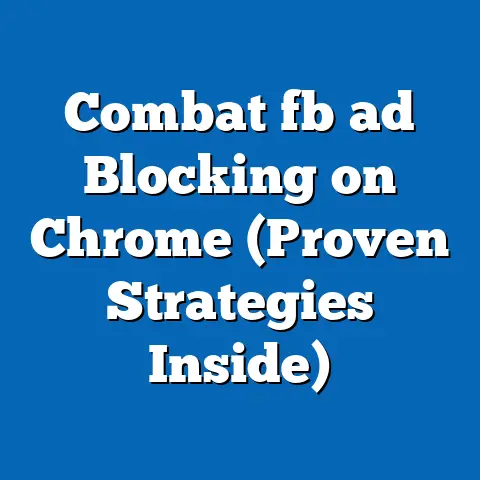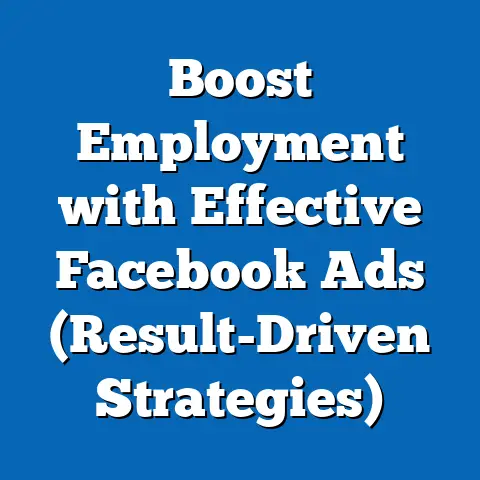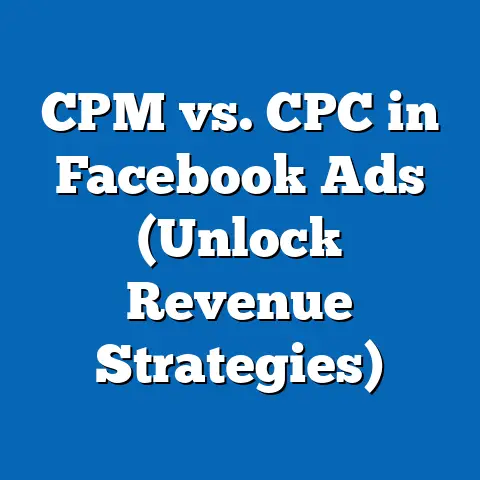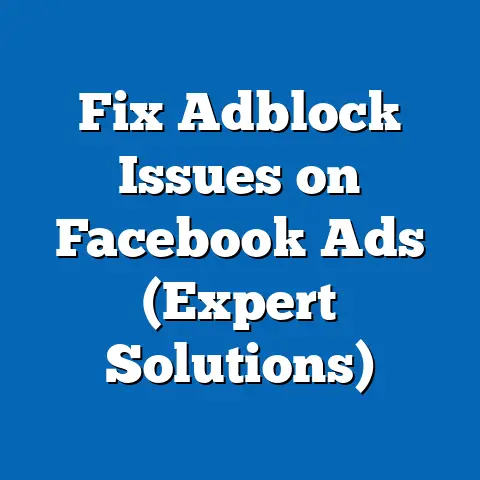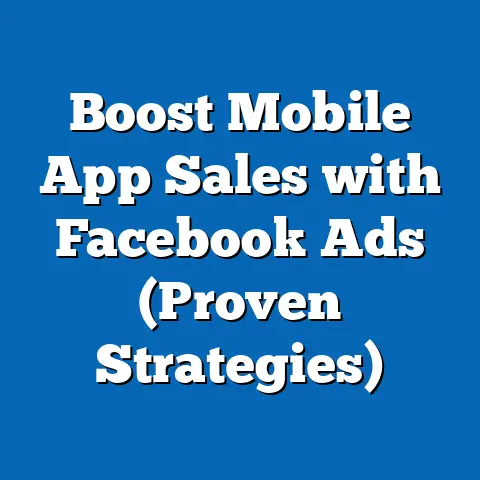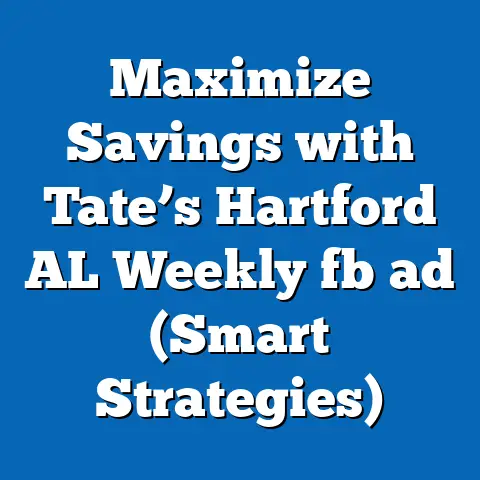Master fb ad Campaigns (Proven Strategies for Success)
I remember the first time I tried running Facebook ads for my own small business. I had this amazing product, a real labor of love, and I was convinced everyone would want it if they just knew it existed. I poured my heart and soul into crafting the perfect website, taking beautiful product photos, and writing compelling descriptions. But when I launched, crickets.
That’s when I turned to Facebook ads. I thought, “This is it! This is how I’ll reach my ideal customer!” I created an ad, boosted a post, and waited for the sales to roll in. Days turned into weeks, and the results were… underwhelming. I felt frustrated, confused, and honestly, a little deflated. It felt like throwing money into a black hole. I knew I wasn’t alone in this struggle. Countless business owners face the same challenges, pouring their hard-earned money into ads that simply don’t deliver. The anxiety of not knowing where your next customer is coming from, the hope that this next campaign will be the one that finally breaks through – it’s a rollercoaster of emotions.
Understanding the Facebook Ad Ecosystem
Facebook is no longer just a social networking site; it’s a massive advertising platform with unparalleled reach and sophisticated targeting capabilities. Understanding this ecosystem is the first step towards creating successful campaigns.
Overview of Facebook Ads
With over 2.9 billion monthly active users, Facebook provides an immense audience for businesses of all sizes. Think about it: nearly half the world’s population is potentially reachable through Facebook ads! According to Statista, Facebook’s advertising revenue in 2023 was over $130 billion, demonstrating the platform’s power and effectiveness for advertisers. This isn’t just about sheer numbers; it’s about the ability to connect with the right people, at the right time, with the right message.
I’ve seen firsthand how a well-targeted Facebook ad can transform a struggling business. I worked with a local bakery that was struggling to attract new customers. By using Facebook’s targeting options to reach people interested in baking, desserts, and local events, we were able to significantly increase their foot traffic and online orders. That’s the power of Facebook ads when used strategically.
Types of Facebook Ads
Facebook offers a variety of ad formats, each with its own strengths and ideal use cases. Choosing the right format is crucial for maximizing engagement and achieving your campaign objectives. Here’s a breakdown of some of the most popular options:
- Image Ads: These are the simplest and most common type of ad. They feature a single image with accompanying text. Image ads are great for showcasing products, highlighting promotions, or driving traffic to your website. When to use them: For simple product announcements, brand awareness, or driving website traffic with a visually appealing image.
- Video Ads: Video ads are highly engaging and can be used to tell stories, demonstrate products, or share customer testimonials. They’re particularly effective for capturing attention in the newsfeed. When to use them: For product demonstrations, storytelling, behind-the-scenes glimpses, or sharing customer testimonials.
- Carousel Ads: Carousel ads allow you to showcase multiple images or videos in a single ad unit. Users can swipe through the carousel to view different products or features. When to use them: For showcasing multiple products, highlighting different features of a single product, or telling a story in a visual sequence.
- Collection Ads: Collection ads are designed for e-commerce businesses. They feature a cover image or video followed by a selection of products. When users click on a product, they’re taken to a full-screen instant experience where they can browse and purchase items. When to use them: For e-commerce businesses looking to drive product discovery and sales.
- Lead Ads: Lead ads make it easy for people to sign up for newsletters, request quotes, or download resources directly from the Facebook app. They’re ideal for generating leads and building your email list. When to use them: For lead generation, building your email list, or collecting information from potential customers.
- Instant Experience Ads: These are full-screen, mobile-optimized experiences that open when someone clicks on your ad. They can be used to showcase products, tell stories, or provide interactive content. When to use them: For creating immersive brand experiences, showcasing products in detail, or providing interactive content.
Choosing the right ad format depends on your specific goals and target audience. Experiment with different formats to see what works best for your business. I’ve found that video ads tend to perform exceptionally well for capturing attention, but image ads can be just as effective when paired with compelling copy and a strong call to action.
The Facebook Ads Manager
The Facebook Ads Manager is your central hub for creating, managing, and analyzing your ad campaigns. It’s a powerful tool, but it can also be a bit overwhelming at first. Let’s take a quick tour of some of the key features:
- Campaigns: This is where you set your overall campaign objective (e.g., awareness, consideration, conversion) and define your budget.
- Ad Sets: Ad sets allow you to define your target audience, placement (where your ads will appear), and schedule.
- Ads: This is where you create your individual ads, including your ad copy, visuals, and call to action.
- Reporting: The reporting dashboard provides detailed insights into your campaign performance, including metrics like impressions, clicks, conversions, and cost per result.
Navigating the Ads Manager can feel daunting at first, but with practice, it becomes second nature. I recommend spending some time exploring the different features and experimenting with different settings. Don’t be afraid to click around and see what each option does. There are also tons of helpful resources available online, including Facebook’s own Help Center and various blog posts and tutorials.
Takeaway: Understanding the Facebook ad ecosystem, including the different ad formats and the Ads Manager, is crucial for creating effective campaigns. Experiment with different options to find what works best for your business.
Setting Clear Objectives
Before you start creating your ads, it’s essential to define your goals. What do you want to achieve with your Facebook ad campaigns? Are you looking to increase brand awareness, generate leads, drive website traffic, or boost sales? Setting clear objectives is the foundation for a successful campaign.
Importance of Goal Setting
Think back to the business owner I mentioned in the introduction. Imagine they launched a Facebook ad campaign without a clear goal in mind. They might get some clicks and impressions, but without a specific objective, it’s impossible to measure success or optimize their campaign effectively. It’s like setting sail without a destination – you might end up somewhere, but it’s unlikely to be where you wanted to go.
Setting clear objectives allows you to:
- Measure your success: How will you know if your campaign is working if you don’t have a clear goal in mind?
- Optimize your campaign: Knowing your objectives allows you to make informed decisions about targeting, ad copy, and bidding strategies.
- Stay focused: Clear goals help you stay on track and avoid getting distracted by vanity metrics.
Different Types of Campaign Objectives
Facebook offers a range of campaign objectives, each designed to achieve a specific outcome. Here’s a breakdown of the main categories:
- Awareness: These objectives are designed to increase brand awareness and reach a wider audience. Options include:
- Brand Awareness: Show your ads to people who are most likely to remember them.
- Reach: Show your ads to the maximum number of people within your target audience.
- Consideration: These objectives are designed to drive engagement and encourage people to learn more about your business. Options include:
- Traffic: Drive traffic to your website, app, or Facebook page.
- Engagement: Get more likes, comments, shares, and event responses.
- App Installs: Encourage people to download your app.
- Video Views: Get more people to watch your video.
- Lead Generation: Collect leads from potential customers using lead ads.
- Messages: Encourage people to message your business on Facebook or Instagram.
- Conversion: These objectives are designed to drive sales and generate leads. Options include:
- Conversions: Drive sales, leads, or other valuable actions on your website or app.
- Catalog Sales: Show products from your catalog to people who are most likely to buy them.
- Store Traffic: Drive foot traffic to your physical store.
- Brand Awareness: Show your ads to people who are most likely to remember them.
- Reach: Show your ads to the maximum number of people within your target audience.
- Traffic: Drive traffic to your website, app, or Facebook page.
- Engagement: Get more likes, comments, shares, and event responses.
- App Installs: Encourage people to download your app.
- Video Views: Get more people to watch your video.
- Lead Generation: Collect leads from potential customers using lead ads.
- Messages: Encourage people to message your business on Facebook or Instagram.
- Conversions: Drive sales, leads, or other valuable actions on your website or app.
- Catalog Sales: Show products from your catalog to people who are most likely to buy them.
- Store Traffic: Drive foot traffic to your physical store.
Choosing the right objective depends on your business goals and where your target audience is in the customer journey. For example, if you’re launching a new product, you might start with an awareness campaign to build brand recognition. Once people are familiar with your brand, you can move on to a consideration campaign to drive engagement and website traffic. Finally, you can launch a conversion campaign to generate leads and sales.
SMART Goals Framework
To ensure your objectives are clear and achievable, I recommend using the SMART goals framework. SMART stands for:
- Specific: Your goal should be clearly defined and easy to understand.
- Measurable: You should be able to track your progress and measure your success.
- Achievable: Your goal should be realistic and attainable.
- Relevant: Your goal should align with your overall business objectives.
- Time-bound: Your goal should have a specific deadline.
Here are a few examples of SMART goals for Facebook ad campaigns:
- Specific: Increase website traffic by 20% in the next month.
- Measurable: Generate 50 leads through lead ads in the next two weeks.
- Achievable: Increase online sales by 10% in the next quarter.
- Relevant: Improve brand awareness among millennials in the local area.
- Time-bound: Drive 100 event registrations by the end of the week.
By setting SMART goals, you can ensure your Facebook ad campaigns are focused, measurable, and aligned with your overall business objectives.
Takeaway: Setting clear, SMART objectives is crucial for campaign success. Choose the right objective based on your business goals and where your target audience is in the customer journey.
Audience Targeting Mastery
One of the most powerful features of Facebook advertising is its ability to target specific audiences based on their demographics, interests, and behaviors. Mastering audience targeting is essential for reaching the right people with your ads and maximizing your ROI.
Defining Your Ideal Customer
Before you start targeting your ads, it’s important to understand who your ideal customer is. Creating customer personas can help you visualize your target audience and identify their key characteristics.
Consider the following factors when defining your ideal customer:
- Demographics: Age, gender, location, education, income, occupation.
- Interests: Hobbies, passions, favorite brands, activities.
- Behaviors: Online habits, purchase history, device usage, travel patterns.
- Pain Points: What problems are they trying to solve? What are their frustrations?
- Goals: What are they trying to achieve? What are their aspirations?
I find that conducting customer surveys and interviews can be incredibly helpful in gathering this information. Talk to your existing customers and ask them about their experiences with your products or services. What do they love about your brand? What could you do better?
Once you have a clear picture of your ideal customer, you can use Facebook’s targeting options to reach them with your ads.
Facebook’s Targeting Options
Facebook offers a variety of targeting options, allowing you to reach specific audiences based on their demographics, interests, and behaviors. Here’s a breakdown of the main categories:
- Core Audiences: Target people based on their demographics, interests, and behaviors. This includes options like:
- Location: Target people living in specific countries, regions, cities, or even zip codes.
- Age: Target people within a specific age range.
- Gender: Target men, women, or both.
- Interests: Target people who have expressed an interest in specific topics, brands, or activities.
- Behaviors: Target people based on their online habits, purchase history, device usage, and travel patterns.
- Custom Audiences: Target people who have already interacted with your business. This includes options like:
- Customer List: Upload a list of your existing customers (email addresses, phone numbers) to target them with your ads.
- Website Traffic: Target people who have visited your website.
- App Activity: Target people who have used your app.
- Engagement: Target people who have engaged with your content on Facebook or Instagram (e.g., liked your page, watched your videos, attended your events).
- Lookalike Audiences: Target people who are similar to your existing customers. Facebook analyzes your customer list or website traffic to identify common characteristics and then finds other people who share those characteristics.
- Location: Target people living in specific countries, regions, cities, or even zip codes.
- Age: Target people within a specific age range.
- Gender: Target men, women, or both.
- Interests: Target people who have expressed an interest in specific topics, brands, or activities.
- Behaviors: Target people based on their online habits, purchase history, device usage, and travel patterns.
- Customer List: Upload a list of your existing customers (email addresses, phone numbers) to target them with your ads.
- Website Traffic: Target people who have visited your website.
- App Activity: Target people who have used your app.
- Engagement: Target people who have engaged with your content on Facebook or Instagram (e.g., liked your page, watched your videos, attended your events).
I’ve seen incredible results with lookalike audiences. By creating a lookalike audience based on my existing customer list, I was able to reach a whole new group of people who were highly likely to be interested in my products. It’s like finding a hidden goldmine of potential customers!
Retargeting Strategies
Retargeting is a powerful strategy that allows you to show ads to people who have already interacted with your business. This can be incredibly effective for driving conversions and increasing sales.
Here are a few retargeting strategies you can use:
- Website Retargeting: Show ads to people who have visited your website but haven’t made a purchase. Remind them of the products they viewed or offer them a special discount to encourage them to buy.
- Cart Abandonment Retargeting: Show ads to people who added items to their shopping cart but didn’t complete the checkout process. Remind them of the items they left behind and offer them free shipping or a discount to encourage them to complete their purchase.
- Video Retargeting: Show ads to people who have watched your videos on Facebook or Instagram. Offer them more relevant content or encourage them to visit your website.
- Lead Ad Retargeting: Show ads to people who have submitted a lead form but haven’t become customers. Follow up with them and provide them with more information about your products or services.
The key to successful retargeting is to create ads that are relevant to the specific actions people have taken. For example, if someone viewed a particular product on your website, show them an ad for that product with a compelling offer.
I always recommend segmenting your retargeting audiences based on their level of engagement. For example, you might show a different ad to someone who visited your website once compared to someone who added items to their cart but didn’t complete the purchase.
Takeaway: Mastering audience targeting is essential for reaching the right people with your ads. Define your ideal customer, use Facebook’s targeting options to reach them, and implement retargeting strategies to drive conversions.
Crafting Compelling Ad Copy and Visuals
Even with the best targeting in the world, your ads won’t be effective if your ad copy and visuals aren’t compelling. Your ads need to grab attention, communicate your message clearly, and persuade people to take action.
The Psychology of Advertising
Advertising isn’t just about presenting information; it’s about tapping into people’s emotions and motivations. Understanding the psychology of advertising can help you create ads that resonate with your target audience and drive results.
Here are a few key psychological principles to keep in mind:
- Loss Aversion: People are more motivated to avoid losses than to gain something of equal value. Highlight the potential consequences of not using your product or service.
- Scarcity: People value things more when they’re scarce or limited. Create a sense of urgency by highlighting limited-time offers or limited quantities.
- Social Proof: People are more likely to take action if they see that others are doing it. Include testimonials, reviews, or social media mentions in your ads.
- Reciprocity: People feel obligated to return favors or gestures. Offer a free gift or discount to encourage people to take action.
- Authority: People are more likely to trust and follow the advice of experts or authority figures. Include endorsements from trusted sources in your ads.
I once worked with a client who was selling a weight loss program. Instead of focusing on the benefits of weight loss (e.g., looking better, feeling healthier), we highlighted the potential consequences of not losing weight (e.g., health problems, low self-esteem). This approach resonated with their target audience and significantly increased conversions.
Writing Engaging Ad Copy
Your ad copy is your opportunity to communicate your message clearly and persuasively. Here are a few tips for writing engaging ad copy:
- Know Your Audience: Write in a language that resonates with your target audience. Use their words and address their specific pain points and goals.
- Highlight Benefits, Not Features: Focus on the benefits of your product or service, not just the features. Explain how it will make their lives better.
- Use Strong Headlines: Your headline is the first thing people will see, so make it count. Use strong, attention-grabbing language that piques their curiosity.
- Include a Clear Call to Action: Tell people exactly what you want them to do. Use strong action verbs like “Shop Now,” “Learn More,” or “Sign Up Today.”
- Keep It Concise: People have short attention spans, so keep your ad copy concise and to the point. Get your message across quickly and effectively.
- Test Different Variations: Experiment with different headlines, body copy, and calls to action to see what works best.
I always recommend writing multiple versions of your ad copy and testing them against each other. Even small changes in your wording can have a big impact on your results.
Designing Eye-Catching Visuals
Your visuals are just as important as your ad copy. They’re what will grab people’s attention as they scroll through their newsfeed. Here are a few tips for designing eye-catching visuals:
- Use High-Quality Images: Use high-resolution images that are clear, well-lit, and visually appealing.
- Choose Relevant Images: Choose images that are relevant to your product or service and that resonate with your target audience.
- Use Color Psychology: Use colors strategically to evoke specific emotions and create a desired mood.
- Maintain Branding Consistency: Use your brand colors, fonts, and logo consistently across all of your ads.
- Keep It Simple: Avoid cluttering your visuals with too much text or too many elements. Keep it simple and easy to understand.
- Test Different Visuals: Experiment with different images, videos, and graphics to see what works best.
There are many tools available to help you create professional-looking visuals, even if you don’t have a background in graphic design. Canva is a popular option that offers a wide range of templates and design elements.
Takeaway: Crafting compelling ad copy and visuals is essential for grabbing attention, communicating your message clearly, and persuading people to take action. Understand the psychology of advertising, write engaging ad copy, and design eye-catching visuals.
Budgeting and Bidding Strategies
Setting the right budget and choosing the right bidding strategy are crucial for maximizing your ROI on Facebook ads. You need to find a balance between spending enough to reach your target audience and avoiding overspending on ineffective ads.
Understanding Ad Budgets
Facebook offers two main types of ad budgets:
- Daily Budget: The average amount you’re willing to spend each day. Facebook will try to spend this amount each day, but it may spend slightly more or less on any given day.
- Lifetime Budget: The total amount you’re willing to spend over the entire duration of your campaign. Facebook will try to spread your budget evenly over the campaign period.
Choosing between a daily and lifetime budget depends on your campaign goals and how much control you want over your spending. A daily budget is a good option if you want to run your ads continuously and have a consistent flow of traffic or leads. A lifetime budget is a good option if you have a specific campaign period in mind and want to ensure you don’t exceed your budget.
Determining the right budget for your Facebook ad campaigns depends on several factors, including:
- Your Goals: What are you trying to achieve with your campaign? Are you looking to increase brand awareness, generate leads, or drive sales?
- Your Target Audience: How large is your target audience? The larger your audience, the more you’ll need to spend to reach them.
- Your Industry: What is the average cost per click (CPC) or cost per impression (CPM) in your industry?
- Your Ad Quality: How relevant and engaging are your ads? High-quality ads tend to have lower costs.
I recommend starting with a small budget and gradually increasing it as you see positive results. This allows you to test different targeting options and ad creatives without risking a lot of money.
Bidding Options
Facebook offers several bidding options, each designed to achieve a specific outcome. Here are a few of the most common options:
- Cost Per Click (CPC): You pay each time someone clicks on your ad. This is a good option if you’re looking to drive traffic to your website or landing page.
- Cost Per Impression (CPM): You pay for every 1,000 impressions your ad receives. This is a good option if you’re looking to increase brand awareness.
- Cost Per Action (CPA): You pay each time someone takes a specific action, such as making a purchase or submitting a lead form. This is a good option if you’re looking to generate leads or drive sales.
- Automatic Bidding: Facebook automatically sets your bids to get you the most results for your budget. This is a good option if you’re new to Facebook advertising or don’t want to spend time manually setting your bids.
Choosing the right bidding strategy depends on your campaign goals and your level of experience. If you’re new to Facebook advertising, I recommend starting with automatic bidding. As you gain more experience, you can experiment with manual bidding to optimize your costs and results.
Monitoring ROI
Tracking your return on investment (ROI) is essential for assessing the success of your ad spend. ROI measures the profitability of your advertising campaigns and helps you determine whether you’re getting a good return on your investment.
To calculate your ROI, you’ll need to track the following metrics:
- Ad Spend: The total amount you’ve spent on your Facebook ad campaigns.
- Revenue: The total revenue generated from your Facebook ad campaigns.
- Cost of Goods Sold (COGS): The cost of producing or acquiring the products or services you’re selling.
The formula for calculating ROI is:
ROI = (Revenue – Ad Spend – COGS) / Ad Spend
For example, if you spent $1,000 on Facebook ads, generated $5,000 in revenue, and had a COGS of $2,000, your ROI would be:
ROI = ($5,000 – $1,000 – $2,000) / $1,000 = 2 or 200%
This means that for every dollar you spent on Facebook ads, you generated $2 in profit.
Monitoring your ROI regularly allows you to identify which campaigns are performing well and which ones need to be optimized or paused.
Takeaway: Setting the right budget and choosing the right bidding strategy are crucial for maximizing your ROI on Facebook ads. Understand the different budget types and bidding options, and monitor your ROI regularly to assess the success of your ad spend.
Analyzing and Optimizing Campaigns
Facebook advertising is not a “set it and forget it” activity. It requires continuous analysis and optimization to ensure you’re getting the best possible results.
Key Metrics to Track
Tracking the right metrics is essential for evaluating the performance of your ad campaigns and identifying areas for improvement. Here are a few of the most important metrics to track:
- Impressions: The number of times your ad was shown to people. This metric indicates how widely your ad is being distributed.
- Reach: The number of unique people who saw your ad. This metric indicates how many different people you’re reaching with your campaign.
- Click-Through Rate (CTR): The percentage of people who saw your ad and clicked on it. This metric indicates how relevant and engaging your ad is.
- Cost Per Click (CPC): The average cost you paid for each click on your ad. This metric indicates how efficiently you’re driving traffic to your website or landing page.
- Conversion Rate: The percentage of people who clicked on your ad and completed a desired action, such as making a purchase or submitting a lead form. This metric indicates how effectively you’re converting traffic into leads or sales.
- Cost Per Acquisition (CPA): The average cost you paid for each conversion. This metric indicates how efficiently you’re acquiring new customers or leads.
- Return on Ad Spend (ROAS): The revenue you generated for every dollar you spent on ads. This metric indicates the overall profitability of your ad campaigns.
I recommend setting up custom dashboards in Facebook Ads Manager to track these metrics in real-time. This will allow you to quickly identify any issues or opportunities and make adjustments to your campaigns as needed.
A/B Testing
A/B testing, also known as split testing, is a powerful technique for finding the most successful ad variations. It involves creating two or more versions of your ad (with slight variations) and showing them to different segments of your target audience. By comparing the performance of the different versions, you can identify which one is most effective.
Here are a few elements you can A/B test in your Facebook ads:
- Headlines: Test different headlines to see which one grabs the most attention.
- Body Copy: Test different body copy to see which one communicates your message most effectively.
- Visuals: Test different images, videos, and graphics to see which one resonates most with your audience.
- Calls to Action: Test different calls to action to see which one drives the most conversions.
- Targeting Options: Test different targeting options to see which audience is most responsive to your ads.
When A/B testing, it’s important to only test one element at a time. This allows you to isolate the impact of each change and determine which one is responsible for the improvement in performance.
I always recommend running A/B tests for at least a week to gather enough data to make statistically significant conclusions.
Continuous Improvement
Facebook advertising is an ongoing process of experimentation, analysis, and optimization. You should never stop testing new ideas and looking for ways to improve your results.
Here are a few strategies for continuous improvement:
- Stay Up-to-Date: Facebook is constantly evolving, so it’s important to stay up-to-date on the latest features, best practices, and algorithm changes.
- Analyze Your Data: Regularly analyze your campaign data to identify trends, patterns, and areas for improvement.
- Test New Ideas: Don’t be afraid to experiment with new targeting options, ad creatives, and bidding strategies.
- Learn From Your Mistakes: Not every campaign will be a success, but you can always learn from your mistakes and use those lessons to improve your future campaigns.
- Seek Inspiration: Look at what other advertisers are doing in your industry and see if you can adapt their strategies to your own campaigns.
I’ve found that the most successful Facebook advertisers are those who are constantly learning, experimenting, and adapting to the ever-changing landscape of the platform.
Takeaway: Analyzing and optimizing your campaigns is essential for maximizing your ROI on Facebook ads. Track the right metrics, use A/B testing to find the most successful ad variations, and commit to continuous improvement.
Conclusion
Mastering Facebook ad campaigns is a journey, not a destination. It requires a deep understanding of the platform, a commitment to continuous learning, and a willingness to experiment and adapt. Throughout this article, we’ve explored the proven strategies that can help you transform your Facebook ad campaigns from a source of frustration to a powerful engine for growth.
We started by understanding the Facebook ad ecosystem, including the different ad formats and the Ads Manager. We then discussed the importance of setting clear, SMART objectives and choosing the right campaign objective based on your business goals. We delved into the art of audience targeting, exploring the various targeting options available and the importance of creating customer personas. We then moved on to crafting compelling ad copy and visuals, understanding the psychology of advertising, and creating ads that resonate with your target audience. We discussed the importance of setting the right budget and choosing the right bidding strategy, and we explored the key metrics to track to assess the success of your ad spend. Finally, we discussed the importance of analyzing and optimizing your campaigns, using A/B testing to find the most successful ad variations, and committing to continuous improvement.
Now, it’s time to take action. I encourage you to apply these strategies to your own Facebook ad campaigns and start seeing the results you’ve been dreaming of. Don’t be afraid to experiment, make mistakes, and learn from your experiences. Remember, every successful Facebook advertiser started somewhere, and with dedication and persistence, you can achieve your goals.
Think back to that business owner I mentioned in the beginning, the one who was struggling to reach their target audience and feeling frustrated and deflated. Imagine them applying these strategies, crafting compelling ads, targeting the right people, and seeing their sales soar. Imagine the relief, the excitement, and the sense of accomplishment they would feel. That’s the power of mastering Facebook ad campaigns. It’s not just about growing your business; it’s about achieving your dreams and building a better future for yourself and your family. So, go out there, embrace the challenge, and unlock the potential of Facebook advertising. Your success story is waiting to be written.

